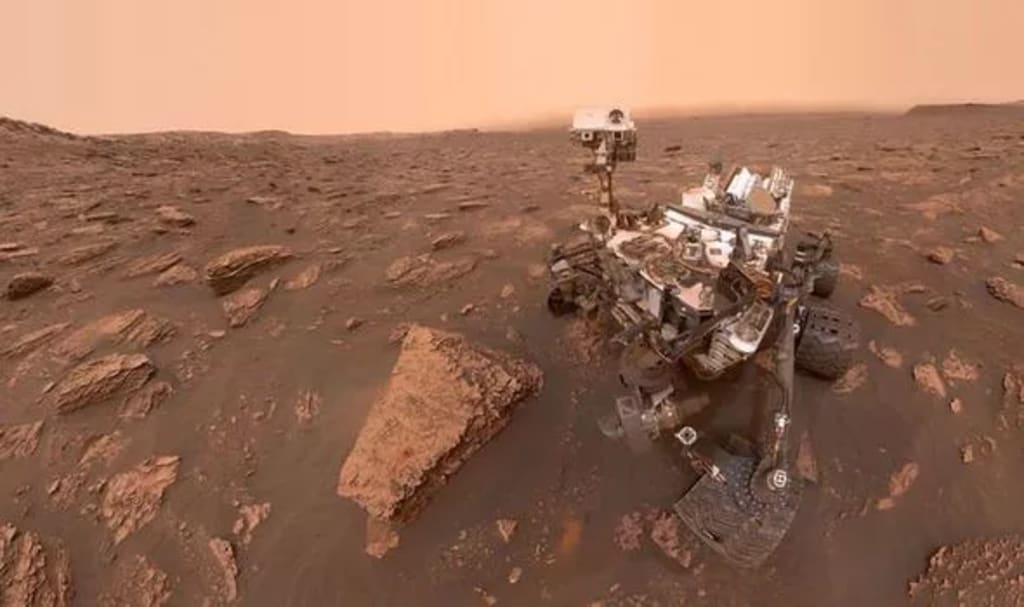Mars' Appearance Defies Expectations
Expectation vs Reality

When we contemplate Mars, we often envision a desolate and lifeless place, devoid of color—a solitary, rusty rock hurtling through space. For a long time, scientists believed Mars to be a truly red planet. From afar, it appears as a small twinkling red dot in the night sky, akin to a glowing ember amidst a sea of stars. As it draws closer to Earth, its reddish hue becomes more pronounced. This fascinating phenomenon has captivated people throughout history, leading to numerous speculations and myths about the nature of Mars.
Astronomers, too, have observed this unique characteristic. They attributed the color to vast deserts covered in iron oxide or rust, thus earning Mars the moniker "the red planet." With the advent of the Space Age, NASA and other space agencies embarked on missions to explore Mars. Early orbiter images further reinforced the perception of Mars as a red-hued world.
However, as technology advanced, orbiters, landers, and rovers such as Spirit, Opportunity, and Curiosity were dispatched to Mars. These interplanetary detectives have provided us with a wealth of knowledge. Orbiters serve as Mars' all-seeing eyes in the sky, capturing stunning images from above, akin to cosmic paparazzi revealing the planet's hidden secrets. Yet, orbiters have limitations, prompting the use of landers and rovers. These robotic adventurers traverse Martian terrains, diligently studying rocks, soil, and the atmosphere.
Thanks to these missions, we have unveiled the truth about Mars. Contrary to the notion of a monotonous red desert, the planet presents a vivid tapestry of colors. Standing on the Martian surface, one would be greeted by a breathtaking array of hues. Sand dunes resembling scrumptious butterscotch desserts stretch across the landscape with warm caramel tones. Valleys and plains glisten with a golden glow, as if hiding precious metal nuggets beneath the surface, awaiting discovery by intrepid space prospectors. Other areas exhibit a brown and tan color palette reminiscent of a Martian safari, evoking shades found in the African savannah. Some regions even display a hint of green, adding a touch of mystery. These green hues indicate the presence of minerals on the planet.
These diverse colors unveil Mars' fascinating geological history, resulting from various minerals and chemical compounds such as olivine, sulfates, and clays. Contrary to the myth of a barren desert, Mars' landscapes are shaped by ancient river channels, volcanoes, impact craters, and shifting sands.
However, alongside these wonders, there is an unfortunate addition. Humans have already left their mark on Mars, even without physically visiting it. Rovers and landers conducting scientific experiments have inadvertently created a celestial landfill, leaving behind discarded spacecraft parts, deflated airbags, and other debris. Although Mars is not truly barren, it may serve as a treasure trove for future archaeologists. Nonetheless, it also serves as a reminder to exercise responsibility in our space exploration endeavors.
Thus, we now know that the real Mars is a vibrant world full of surprises. Yet, it is not the only cosmic body that has surpassed our initial imaginations. Pluto, once considered the ninth planet in our solar system, now classified as a dwarf planet, has revealed itself to be more intriguing than expected. When the New Horizons spacecraft flew past Pluto in 2015, it unveiled a true appearance different from the previous perception of a frozen, icy world. Pluto's surface showcases a mix of reddish brown and charcoal black hues, resembling a stylish outfit for a formal cosmic event. As one approaches, a breathtaking array of colors becomes apparent, with patches of crimson red, giving the landscape a dramatic touch. Charcoal black areas add a moody and mysterious vibe, while blends of orange, yellow, and white create stunning regions. Additionally, icy mountains shimmer with a hint of blue, emanating an otherworldly glow.
Pluto's dynamic nature is demonstrated by its mountains, particularly the tallest peak, Tenzing Montes, nearly as tall as Mount Everest. Vast icy plains, smooth as a skating rink, dot its surface, inviting us to glide across this frozen expanse. Furthermore, New Horizons revealed a heart-shaped region on Pluto's surface called Tombaugh Regio, made of icy plains. This little planetary oddball surprises us with its abundance of love.
Saturn's moon, Titan, also defied our previous assumptions of a barren and desolate moon. It turns out to be a celestial wonderland. Instead of the expected dull grays and browns, Titan's surface is enveloped in a thick haze, creating an ethereal orange glow—a mystical mist that adds an otherworldly touch. Titan boasts lakes, rivers, and seas, but not of water. Its frigid atmosphere is home to liquid hydrocarbons like ethane and methane. Imagining oneself standing on the shores of a lake, with liquid methane gently lapping against the rocky coastline, under a hazy orange sky, offers a surreal blend of Earth and extraterrestrial worlds.
Lastly, Jupiter, the largest planet in our solar system, has also exceeded our imagination. It has often been depicted as an orange planet with swirling red and brown bands. However, images captured by NASA's Juno mission have shown that Jupiter's atmosphere is dominated by shades of red, orange, brown, and white. These images reveal intricate cloud patterns, massive storms, and a complex belt system, making Jupiter even more breathtaking and diverse than previously thought.
In conclusion, our imaginations can fall short when contemplating the captivating beauty and diversity of the cosmos. The reality of distant worlds can be even more astonishing than our wildest dreams. So, the next time you gaze at the night sky, remember that the wonders of the universe may surpass your imagination.





Comments
Mela Mandigma is not accepting comments at the moment
Want to show your support? Send them a one-off tip.